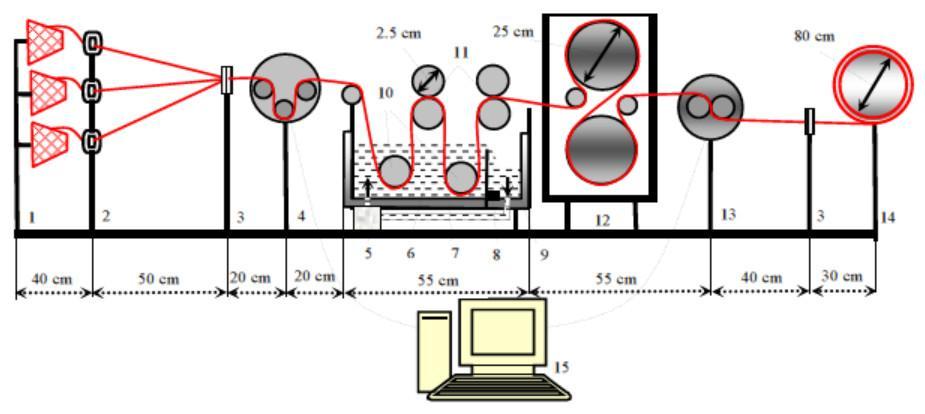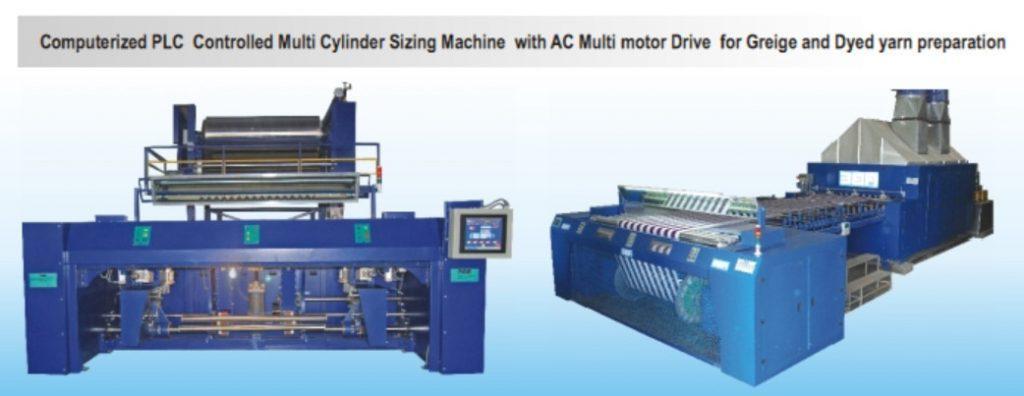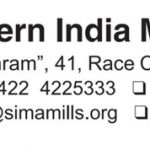 Laboratory sizing machine: 1—creel for cross wound bobbins, 2—thread tensioners, 3—comb, 4—tensiometer, 5—pump, 6—size box, 7—double wall of the size box, 8—thermostat, 9—prewetting size box, 10—immersion rollers, 11—size squeezing rollers, 12—contact dryer, 13—moisture measurement unit, 14—yarn winder, 15—computer with A/D converter for data storage.
Laboratory sizing machine: 1—creel for cross wound bobbins, 2—thread tensioners, 3—comb, 4—tensiometer, 5—pump, 6—size box, 7—double wall of the size box, 8—thermostat, 9—prewetting size box, 10—immersion rollers, 11—size squeezing rollers, 12—contact dryer, 13—moisture measurement unit, 14—yarn winder, 15—computer with A/D converter for data storage.
The key technological takeaways from the research paper “Synthetized Potato Starch – A New Eco Sizing Agent for Cotton Yarns”
Abstract
The objective of this research was to verify the feasibility of the use of newly synthesized biopolymer materials for sizing cotton yarns based on the basic principles of chemical modification. Research included acid hydrolysis of potato starch up to controlled molar masses together with graft-polymerization and methacrylic acid onto hydrolyzed starch to improve hydrophilicity and solubility, to increase the capability of film forming, to increase adhesive potential and to avoid retrogradation phenomena. Research objectives were primarily focused on finding an appropriate, environmentally-friendly and productive sizing agent for cotton yarns via the analysis and systematization of a large number of synthesis methods in conjunction with the characterization and properties of graft-copolymers. The research results showed that potassium persulfate initiator was most efficient in grafting of methacrylic acid onto hydrolyzed starch, while azobisisobutyronitrile (AIBIN) initiator was most efficient in grafting of acrylic acid (AC). FTIR analysis confirmed that new and efficient products for sizing cotton yarns from synthetized potato starch were obtained. Research on rheological properties of copolymers shows a higher viscosity of grafted products indicating the good stability of potential starches. Ecological improvements have been established through high desizing degree as well as improvements in physical-mechanical properties of yarn, abrasion resistance and decrease in yarn surface hairiness were noticed. The use of new derivatives of potato starch, especially of hydrolyzed starch grafted with methacrylic acid (MAA), potassium persulfate (KPS) as initiator, was confirmed.
Sizing is a technological process of wet processing of warp yarns to obtain additional properties which are necessary for weaving. The sizing process is nowadays more aimed towards the development and use of natural-based sizing agents. The sizing process is one of the most important and expensive phases in fabric manufacturing; so its contribution in its development and improvement is reflected through the development and automation of sizing machines and the introduction of new, more efficient and more cost effective sizing agents. By using synthetic polymer products, sizing gains significance as a phase in which yarn properties can be greatly optimized, which significantly increases the productivity of the weaving mill and fabric quality. The basic objective of sizing is that the use of the appropriate polymer capable of forming a protective layer on the yarn provides the durability of warp threads and their minimum deformation during short and strong cyclic stresses in the weaving process .
Sizing efficacy does not depend only on the adhesion between the applied sizing agent and the yarn, but also on the ability to form a film, on rheological properties of the size, physical-chemical yarn properties, as well as on the technological parameters in the sizing process. Furthermore, it is necessary to completely remove the sizing agent from the fabric after the weaving process in an environmentally friendly manner. Under production conditions it often happens that inadequate sizing agents are used, especially inadequate recipes.
The optimization of the proportion and application of sizing agents to the warp threads is of the utmost importance for the entire weaving process in order to achieve the planned machine utilization and the quality of the finished fabric. Optimization of size pick-up is one of the biggest problem in the sizing process even today. The purpose of sizing is to reduce the number of warp thread breakages to a minimum.
Sizing Agents
Based on the chemical composition, the sizing agents used nowadays can be divided into the following groups: starches, carboxymethylcellulose, polyvinyl alcohols, polyacrylates and polyester resins. From the group of starches, potato is one of the most commonly used. It disadvantage is that a small drop in temperature suddenly changes the rheological properties of size, and this results in retrogradation, which causes difficult control of the degree of sizing.
Starch properties depend on the relationship between amylose and amylopectin, but also on other constituents found in a starch granule, such as phosphates, lipids, phospholipids, etc. However, amylopectin, as the main starch ingredient, exerts a dominant influence on starch properties. The lateral chain length in amylopectin affects clustering, retrogradation and starch properties in the solution. In cold water starch swells, but does not dissolve. Starch granules disintegrate only at elevated temperatures, i.e., dissolving happens whereby amorphous amylose is released first which forms a three-dimensional network outside starch granules and inhibits further swelling of starch granules. Besides amylose, the present lipids also inhibit swelling. Although amylose makes only a slight contribution to the viscosity of the starch solution after granule disintegration, when cooling the viscosity of the starch solution increases with increasing amylose content, which is explained with amylose crystallization and gel structure formation. It is known that, if starch solution is allowed to stand, starch retrogradation occurs, which is one of bad indicators for commercial use as a sizing agent. An increase in the concentration and a decrease in the solution temperature accelerate retrogradation, while very short chains (degree of polymerization 6–9) suppress starch retrogradation
Starch is mostly commercially applied in sizing cotton warp yarns, although with considerable shortcomings: (a) molecule size which limits the penetration into the yarn, (b) instability of size viscosity due to temperature changes during cooking until preparation and sizing process, (c) film rigidity (in particular in the absence of a high-quality lubricant), (d) sensitivity to microorganisms (decay, degradation). Modification of natural starches is done just to eliminate the above mentioned shortcomings and to increase their usability for industrial applications.
Hydrolysis of potato starch and vinyl monomers—acrylic (AA) and methacrylic acid (MAA) by using various initiators (azobisizobutyronitrile (AIBN), potassium persulfate (KPS) and benzoyl peroxide (BPO) was performed. The use of AA monomer in the process of grafting natural starch was found in textile finishing, but not in yarn sizing. Also, the absence of research of starch MAA grafting for use in sizing was crucial for their choice, assuming the behavior in the practice of the modified size film on the yarn, taking into consideration the presence of polar and non-polar parts in the structure of sizing agents. Hydrolysis of starch was carried out in order to reduce molar mass, which implies easier solubility without bulky agglomerates in the size, easier penetration into the yarn structure and later easier removal from the fabric. Monomers were grafted onto shorter starch macromolecules, creating lateral shorter or longer branches on the main chain, thus forming a product for a more efficient use in yarn processing. A variation of the initiator was performed in order to form grafted monomers more efficiently on the starch and because of the differences of bonded ones on longer or shorter lateral chains and/or denser packing of lateral chains. Later, that can greatly affect size rheology and the behavior of the film on the impregnated yarn.
The use of ultrasound in washing, as an additional source of highly usable energy, brings significant improvements, i.e., the removal of the size material from the warp yarn is more intensive.
Starch is mostly commercially applied in sizing cotton warp yarns, although with considerable shortcomings: (a) molecule size which limits the penetration into the yarn, (b) instability of size viscosity due to temperature changes during cooking until preparation and sizing process, (c) film rigidity (in particular in the absence of a high-quality lubricant), (d) sensitivity to microorganisms (decay, degradation). Modification of natural starches is done just to eliminate the above mentioned shortcomings and to increase their usability for industrial applications [20,21,22,23].
Hydrolysis of potato starch and vinyl monomers—acrylic (AA) and methacrylic acid (MAA) by using various initiators (azobisizobutyronitrile (AIBN), potassium persulfate (KPS) and benzoyl peroxide (BPO) was performed. The use of AA monomer in the process of grafting natural starch was found in textile finishing, but not in yarn sizing.
Yarn Hairiness
Hairiness can be defined as the state of migrated fiber ends and fiber loops pushed to the surface of the yarn body, not adhering to it. Some fibers have one of their ends fixed inside the yarn while others protrude under the influence of mechanical and geometrical causes. The intensity of yarn hairiness depends on the spinning method, degree of fiber parallelization, fiber types and lengths, yarn twist and other causes. One of the goals of sizing is to reduce yarn hairiness which negatively affects yarn abrasion in contact with the elements of the weaving machine.
The viscosity of the sizing liquor, which is also defined as its flow, mostly depends on the time of left standing unused, on circulation and temperature. During the preparation of the solution it is noted that at lower concentrations of up to 3%, the solution of hydrolyzed potato starch behaves almost like a Newtonian fluid, i.e., starch macromolecules are sufficiently distant so that no strong physical crosslinking occurs. Potentially formed bonds are easily broken under the action of mechanical forces and during testing they fail to form again. By analyzing the relationship between hydrophilic and hydrophobic interactions and the effects of secondary chemical bonds, it is noticed that the grafted macromolecule exhibits a specific behavior in the solution, which is reflected in viscosity and then in binding to the cotton yarn in the sizing process.
Size Modification
For the purposes of this research potato starch was used for hydrolysis and afterwards for grafting of various monomers. Starch hydrolysis was carried out to reduce molar weight, to increase the solubility and availability of active centers for chemical modification. Graft copolymerization was carried out whereby monomers were grafted onto shorter starch macromolecules, forming lateral branches on the main chain resulting in a product, which can be more efficiently used as a sizing agent.
In the weaving process warp threads are strained and subjected to dynamic stresses, resulting in their deformation and breakage. It is not necessary to size the ply yarn with the amount of starch as a single yarn because ply yarns mostly have satisfactory tenacity properties. In that case, it is only sufficient to connect the fibers on the yarn surface, which is conducted by using lower concentrates of starch. The size was prepared by mixing sizing agents in cold distilled water. After grinding, the bath was gradually heated with intense mixing up to 80 °C during 30 min and then 5 min at a temperature of 95 °C. Afterwards the size paste is ready for sizing, and the following conditions are adapted before sizing:
- Thread tension in the entry into the size box: 42 cN
- Size temperature: 85 °C
- Sizing speed: 3 m/min
- Pressure on the last pair of size paste squeezing rollers: 1.5 N/cm2
- Drying temperature: 110–130 °C
- Exit moisture: 5.5%.
Materials
For the purposes of this research 100% ring spun single cotton yarns with counts of 20 tex and 30 tex (700 twists/m) and ply yarns with counts of 20 × 2 tex and 30 × 2 tex (324 twists/m) were used. Egyptian cotton fibers with lengths 27–28 mm and average diameter of 4.5 μm were spun into a yarn. The yarn was spun and plied by the Textile Company Bimtex, Leskovac, Serbia.
For the purpose of this research the following active products were used: potato starch (25 wt.% amylose, “Jabuka” Starch Industry, Pančevo, Serbia), hydrochloric acid—HCl (Centrohem, Stara Pazova, Serbia), ethyl alcohol (ethanol)—C2H5OH (Reahem, Novi Sad, Serbia) and sodium carbonate—Na2CO3 (LG Hemija, Belgrade, Serbia).
“Synthetized Potato Starch – A New Eco Sizing Agent for Cotton Yarns”
Authors: Stana Kovačević and Ivana Schwarz *
Dept of Textile Design and Management, Faculty of Textile Technology, University of Zagreb, Prilaz baruna Filipovića 28a, 10000 Zagreb, Croatia Suzana Đorđević Textile Department, Higher Technological and Artistic Professional School Leskovac, Vilema Pusmana 17, 16000 Leskovac, Serbia Dragan Đorđević Textile Department, Faculty of Technology, University of Nis, Bulevar Oslobodjenja 124, 16000 Leskovac, Serbia
* Author to whom correspondence should be addressed.
(Source: Polymers 2019, 11(5), 908; https://doi.org/10.3390/polym11050908)
 Laboratory Sizing Machine from R. B. Electronic & Engineering Pvt. Ltd. (For illustration purpose)
Laboratory Sizing Machine from R. B. Electronic & Engineering Pvt. Ltd. (For illustration purpose)
R.B. Electronic & Engineering Pvt Ltd.
301 Kilfire House, C-17 Dalia Industrial Estate Off Andheri- Borivali Link Road Opp Laxmi Industrial Estate Andheri (West) Mumbai -400053
Email: [email protected]





